PROJ6010 - Project Management: SAHMRI Project Analysis Report
VerifiedAdded on 2023/01/19
|15
|3564
|60
Report
AI Summary
This report provides a comprehensive analysis of the SAHMRI research center project, focusing on project influences, viability, and planning. The report begins with an introduction to the project, highlighting the importance of project management practices in the construction industry. Part A of the report conducts a PESTLE analysis to examine the political, economic, social, technological, legal, and environmental factors influencing the project. It also outlines the steps project managers should take and evaluates the decisions made for the project. Part B assesses project viability, discussing feasibility decisions, approaches to project size and scale, and the need for cost and profitability estimations. It also examines the effectiveness of the decisions made. Part C focuses on project planning, describing the impact of various plans. The report concludes with recommendations and a summary of the key findings, offering valuable insights into the successful management of the SAHMRI research center project.
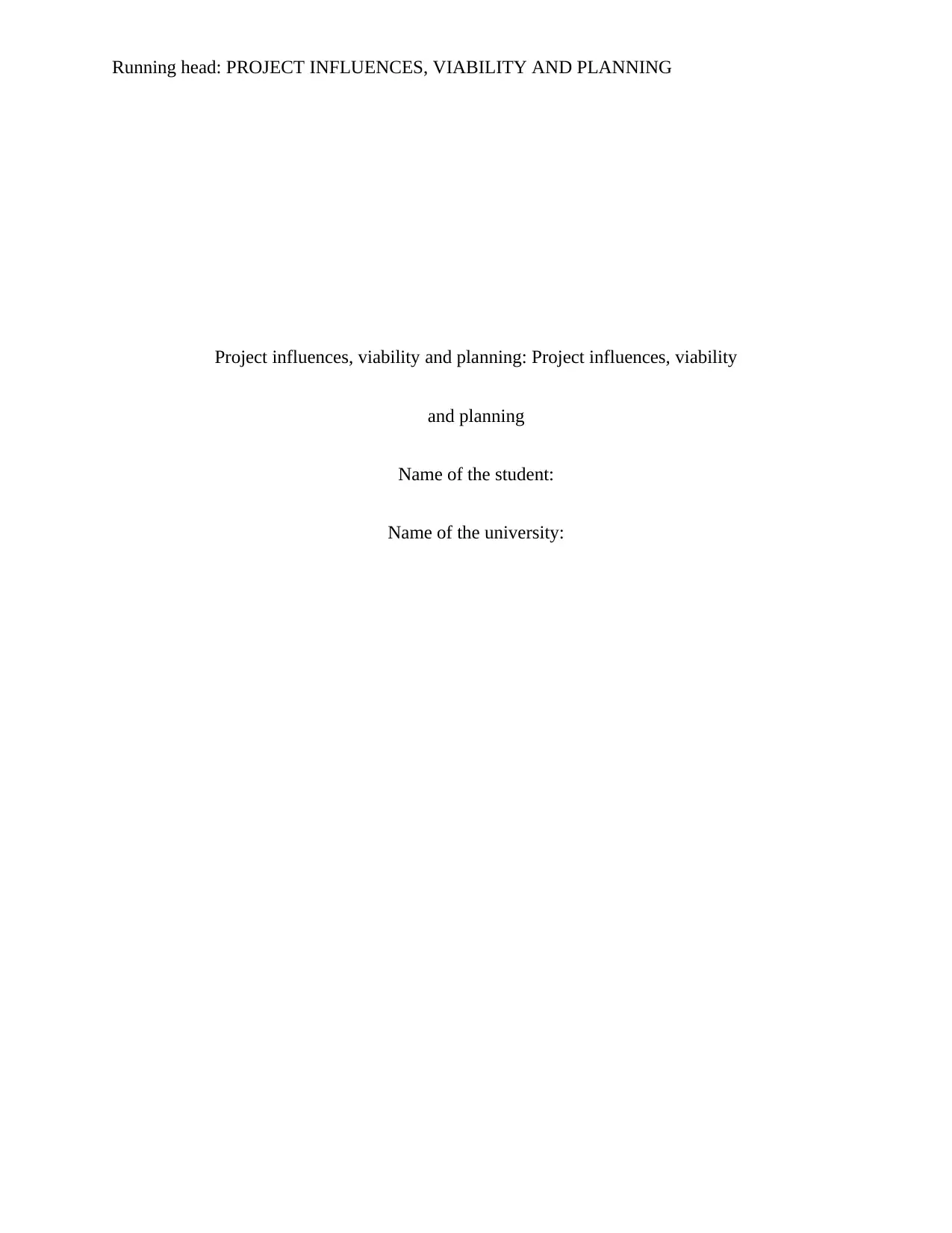
Running head: PROJECT INFLUENCES, VIABILITY AND PLANNING
Project influences, viability and planning: Project influences, viability
and planning
Name of the student:
Name of the university:
Project influences, viability and planning: Project influences, viability
and planning
Name of the student:
Name of the university:
Paraphrase This Document
Need a fresh take? Get an instant paraphrase of this document with our AI Paraphraser
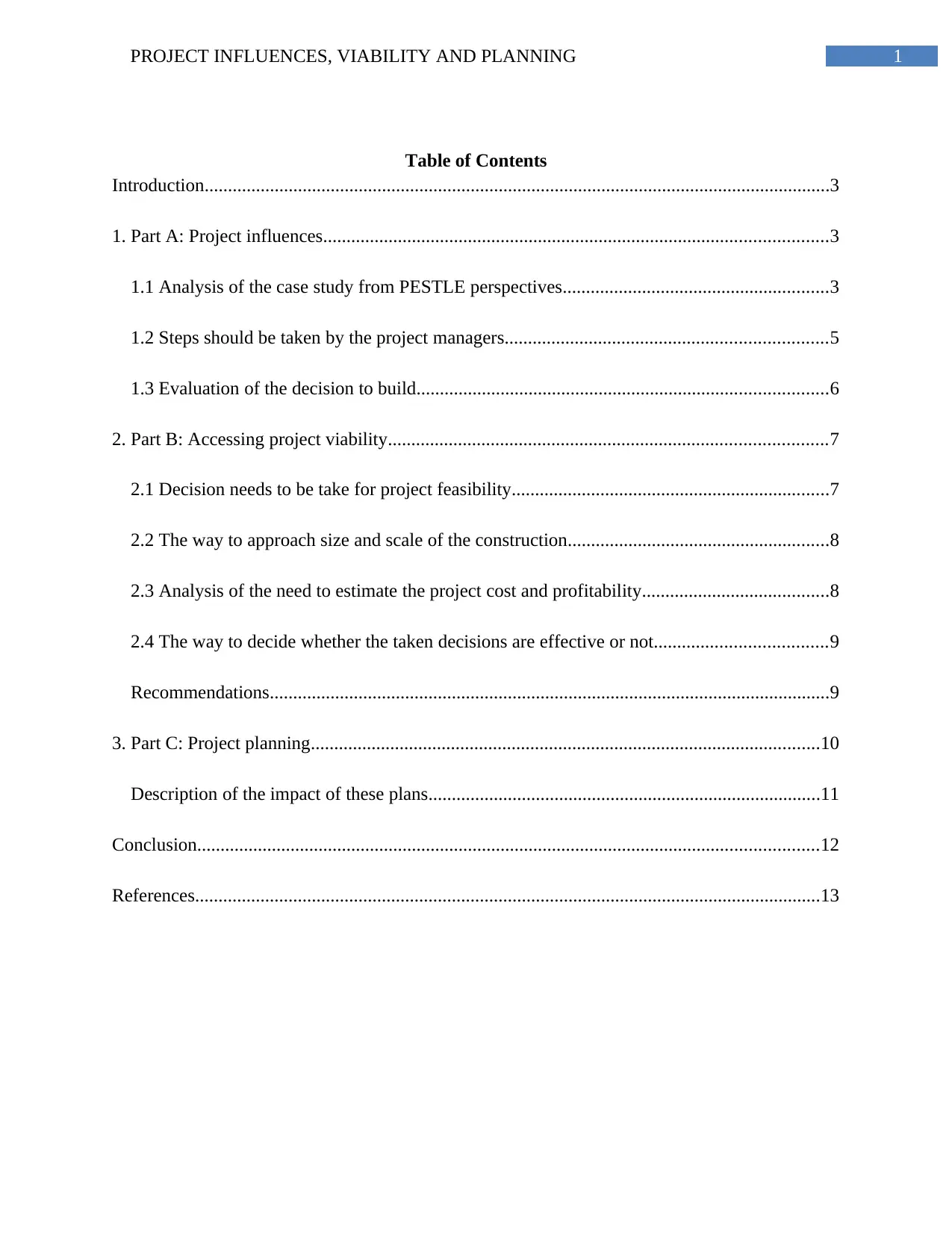
1PROJECT INFLUENCES, VIABILITY AND PLANNING
Table of Contents
Introduction......................................................................................................................................3
1. Part A: Project influences............................................................................................................3
1.1 Analysis of the case study from PESTLE perspectives.........................................................3
1.2 Steps should be taken by the project managers.....................................................................5
1.3 Evaluation of the decision to build........................................................................................6
2. Part B: Accessing project viability..............................................................................................7
2.1 Decision needs to be take for project feasibility....................................................................7
2.2 The way to approach size and scale of the construction........................................................8
2.3 Analysis of the need to estimate the project cost and profitability........................................8
2.4 The way to decide whether the taken decisions are effective or not.....................................9
Recommendations........................................................................................................................9
3. Part C: Project planning.............................................................................................................10
Description of the impact of these plans....................................................................................11
Conclusion.....................................................................................................................................12
References......................................................................................................................................13
Table of Contents
Introduction......................................................................................................................................3
1. Part A: Project influences............................................................................................................3
1.1 Analysis of the case study from PESTLE perspectives.........................................................3
1.2 Steps should be taken by the project managers.....................................................................5
1.3 Evaluation of the decision to build........................................................................................6
2. Part B: Accessing project viability..............................................................................................7
2.1 Decision needs to be take for project feasibility....................................................................7
2.2 The way to approach size and scale of the construction........................................................8
2.3 Analysis of the need to estimate the project cost and profitability........................................8
2.4 The way to decide whether the taken decisions are effective or not.....................................9
Recommendations........................................................................................................................9
3. Part C: Project planning.............................................................................................................10
Description of the impact of these plans....................................................................................11
Conclusion.....................................................................................................................................12
References......................................................................................................................................13
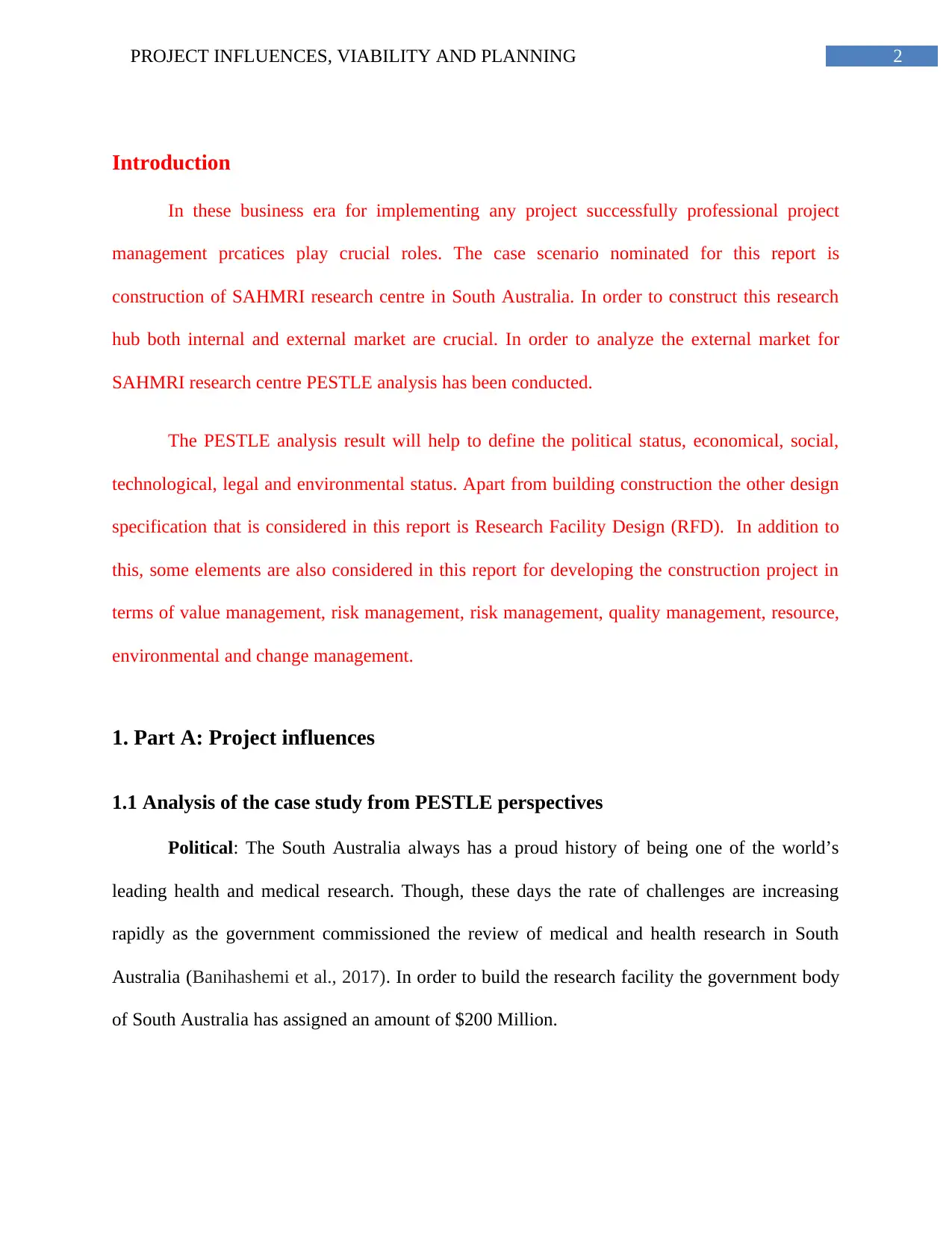
2PROJECT INFLUENCES, VIABILITY AND PLANNING
Introduction
In these business era for implementing any project successfully professional project
management prcatices play crucial roles. The case scenario nominated for this report is
construction of SAHMRI research centre in South Australia. In order to construct this research
hub both internal and external market are crucial. In order to analyze the external market for
SAHMRI research centre PESTLE analysis has been conducted.
The PESTLE analysis result will help to define the political status, economical, social,
technological, legal and environmental status. Apart from building construction the other design
specification that is considered in this report is Research Facility Design (RFD). In addition to
this, some elements are also considered in this report for developing the construction project in
terms of value management, risk management, risk management, quality management, resource,
environmental and change management.
1. Part A: Project influences
1.1 Analysis of the case study from PESTLE perspectives
Political: The South Australia always has a proud history of being one of the world’s
leading health and medical research. Though, these days the rate of challenges are increasing
rapidly as the government commissioned the review of medical and health research in South
Australia (Banihashemi et al., 2017). In order to build the research facility the government body
of South Australia has assigned an amount of $200 Million.
Introduction
In these business era for implementing any project successfully professional project
management prcatices play crucial roles. The case scenario nominated for this report is
construction of SAHMRI research centre in South Australia. In order to construct this research
hub both internal and external market are crucial. In order to analyze the external market for
SAHMRI research centre PESTLE analysis has been conducted.
The PESTLE analysis result will help to define the political status, economical, social,
technological, legal and environmental status. Apart from building construction the other design
specification that is considered in this report is Research Facility Design (RFD). In addition to
this, some elements are also considered in this report for developing the construction project in
terms of value management, risk management, risk management, quality management, resource,
environmental and change management.
1. Part A: Project influences
1.1 Analysis of the case study from PESTLE perspectives
Political: The South Australia always has a proud history of being one of the world’s
leading health and medical research. Though, these days the rate of challenges are increasing
rapidly as the government commissioned the review of medical and health research in South
Australia (Banihashemi et al., 2017). In order to build the research facility the government body
of South Australia has assigned an amount of $200 Million.
⊘ This is a preview!⊘
Do you want full access?
Subscribe today to unlock all pages.

Trusted by 1+ million students worldwide
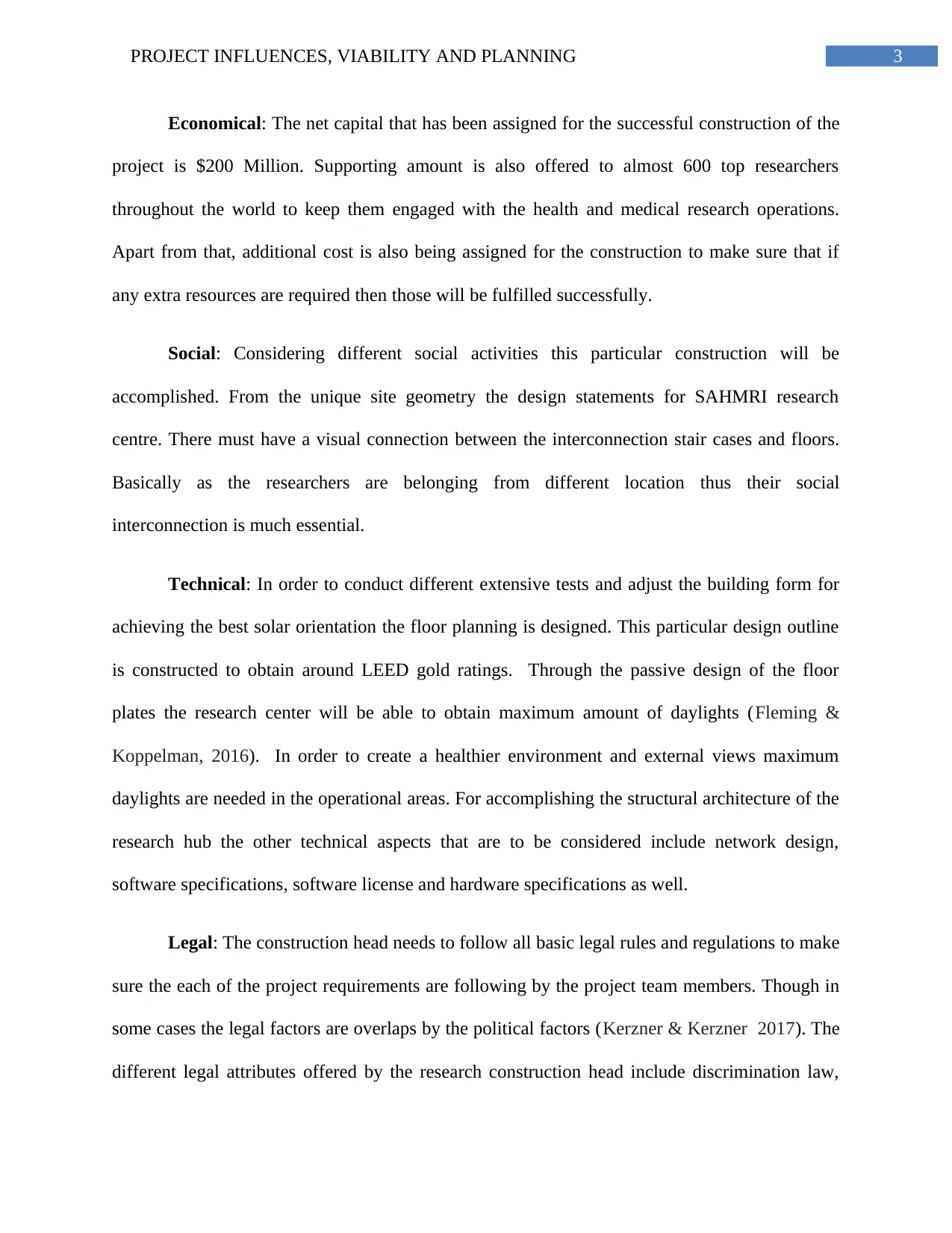
3PROJECT INFLUENCES, VIABILITY AND PLANNING
Economical: The net capital that has been assigned for the successful construction of the
project is $200 Million. Supporting amount is also offered to almost 600 top researchers
throughout the world to keep them engaged with the health and medical research operations.
Apart from that, additional cost is also being assigned for the construction to make sure that if
any extra resources are required then those will be fulfilled successfully.
Social: Considering different social activities this particular construction will be
accomplished. From the unique site geometry the design statements for SAHMRI research
centre. There must have a visual connection between the interconnection stair cases and floors.
Basically as the researchers are belonging from different location thus their social
interconnection is much essential.
Technical: In order to conduct different extensive tests and adjust the building form for
achieving the best solar orientation the floor planning is designed. This particular design outline
is constructed to obtain around LEED gold ratings. Through the passive design of the floor
plates the research center will be able to obtain maximum amount of daylights (Fleming &
Koppelman, 2016). In order to create a healthier environment and external views maximum
daylights are needed in the operational areas. For accomplishing the structural architecture of the
research hub the other technical aspects that are to be considered include network design,
software specifications, software license and hardware specifications as well.
Legal: The construction head needs to follow all basic legal rules and regulations to make
sure the each of the project requirements are following by the project team members. Though in
some cases the legal factors are overlaps by the political factors (Kerzner & Kerzner 2017). The
different legal attributes offered by the research construction head include discrimination law,
Economical: The net capital that has been assigned for the successful construction of the
project is $200 Million. Supporting amount is also offered to almost 600 top researchers
throughout the world to keep them engaged with the health and medical research operations.
Apart from that, additional cost is also being assigned for the construction to make sure that if
any extra resources are required then those will be fulfilled successfully.
Social: Considering different social activities this particular construction will be
accomplished. From the unique site geometry the design statements for SAHMRI research
centre. There must have a visual connection between the interconnection stair cases and floors.
Basically as the researchers are belonging from different location thus their social
interconnection is much essential.
Technical: In order to conduct different extensive tests and adjust the building form for
achieving the best solar orientation the floor planning is designed. This particular design outline
is constructed to obtain around LEED gold ratings. Through the passive design of the floor
plates the research center will be able to obtain maximum amount of daylights (Fleming &
Koppelman, 2016). In order to create a healthier environment and external views maximum
daylights are needed in the operational areas. For accomplishing the structural architecture of the
research hub the other technical aspects that are to be considered include network design,
software specifications, software license and hardware specifications as well.
Legal: The construction head needs to follow all basic legal rules and regulations to make
sure the each of the project requirements are following by the project team members. Though in
some cases the legal factors are overlaps by the political factors (Kerzner & Kerzner 2017). The
different legal attributes offered by the research construction head include discrimination law,
Paraphrase This Document
Need a fresh take? Get an instant paraphrase of this document with our AI Paraphraser
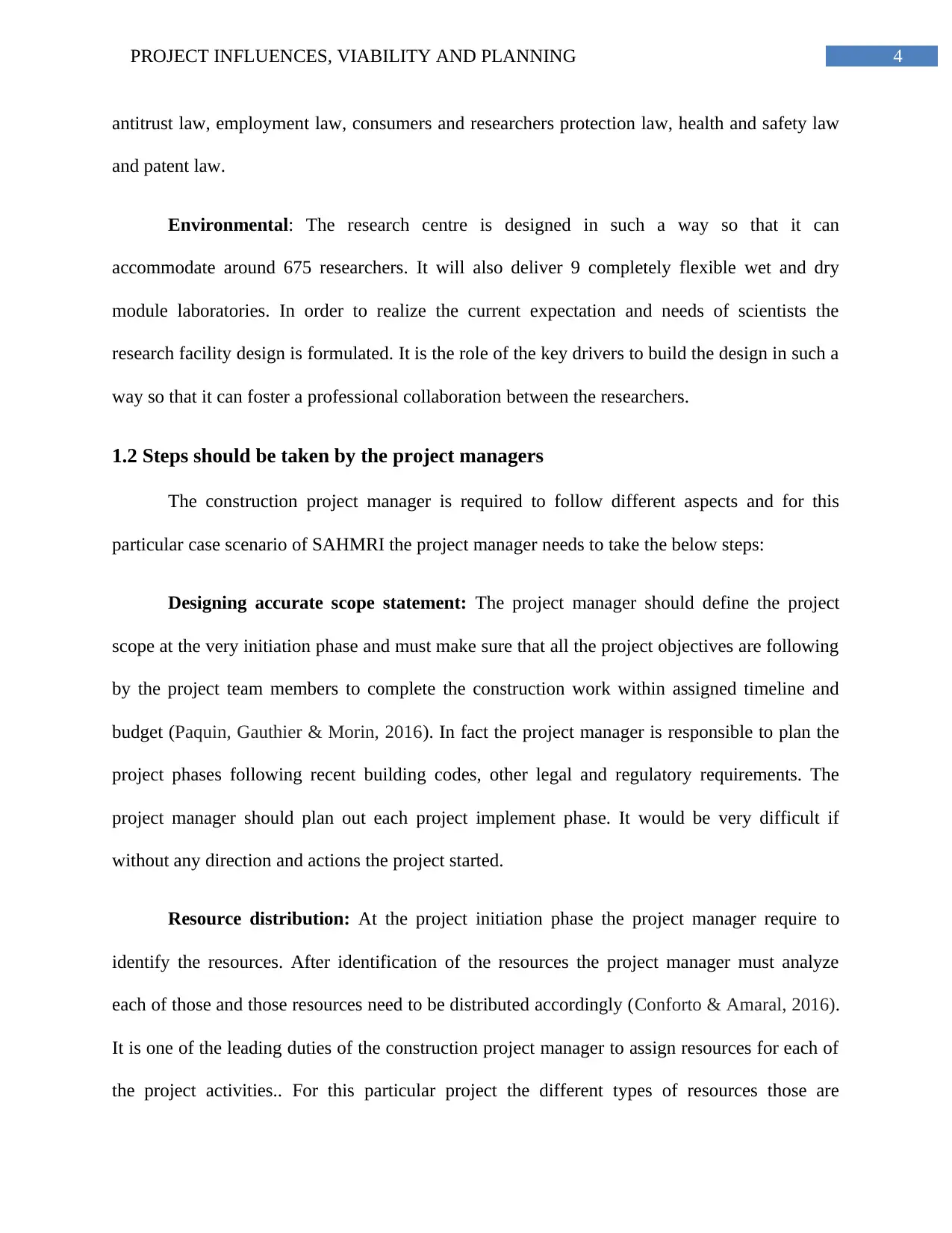
4PROJECT INFLUENCES, VIABILITY AND PLANNING
antitrust law, employment law, consumers and researchers protection law, health and safety law
and patent law.
Environmental: The research centre is designed in such a way so that it can
accommodate around 675 researchers. It will also deliver 9 completely flexible wet and dry
module laboratories. In order to realize the current expectation and needs of scientists the
research facility design is formulated. It is the role of the key drivers to build the design in such a
way so that it can foster a professional collaboration between the researchers.
1.2 Steps should be taken by the project managers
The construction project manager is required to follow different aspects and for this
particular case scenario of SAHMRI the project manager needs to take the below steps:
Designing accurate scope statement: The project manager should define the project
scope at the very initiation phase and must make sure that all the project objectives are following
by the project team members to complete the construction work within assigned timeline and
budget (Paquin, Gauthier & Morin, 2016). In fact the project manager is responsible to plan the
project phases following recent building codes, other legal and regulatory requirements. The
project manager should plan out each project implement phase. It would be very difficult if
without any direction and actions the project started.
Resource distribution: At the project initiation phase the project manager require to
identify the resources. After identification of the resources the project manager must analyze
each of those and those resources need to be distributed accordingly (Conforto & Amaral, 2016).
It is one of the leading duties of the construction project manager to assign resources for each of
the project activities.. For this particular project the different types of resources those are
antitrust law, employment law, consumers and researchers protection law, health and safety law
and patent law.
Environmental: The research centre is designed in such a way so that it can
accommodate around 675 researchers. It will also deliver 9 completely flexible wet and dry
module laboratories. In order to realize the current expectation and needs of scientists the
research facility design is formulated. It is the role of the key drivers to build the design in such a
way so that it can foster a professional collaboration between the researchers.
1.2 Steps should be taken by the project managers
The construction project manager is required to follow different aspects and for this
particular case scenario of SAHMRI the project manager needs to take the below steps:
Designing accurate scope statement: The project manager should define the project
scope at the very initiation phase and must make sure that all the project objectives are following
by the project team members to complete the construction work within assigned timeline and
budget (Paquin, Gauthier & Morin, 2016). In fact the project manager is responsible to plan the
project phases following recent building codes, other legal and regulatory requirements. The
project manager should plan out each project implement phase. It would be very difficult if
without any direction and actions the project started.
Resource distribution: At the project initiation phase the project manager require to
identify the resources. After identification of the resources the project manager must analyze
each of those and those resources need to be distributed accordingly (Conforto & Amaral, 2016).
It is one of the leading duties of the construction project manager to assign resources for each of
the project activities.. For this particular project the different types of resources those are
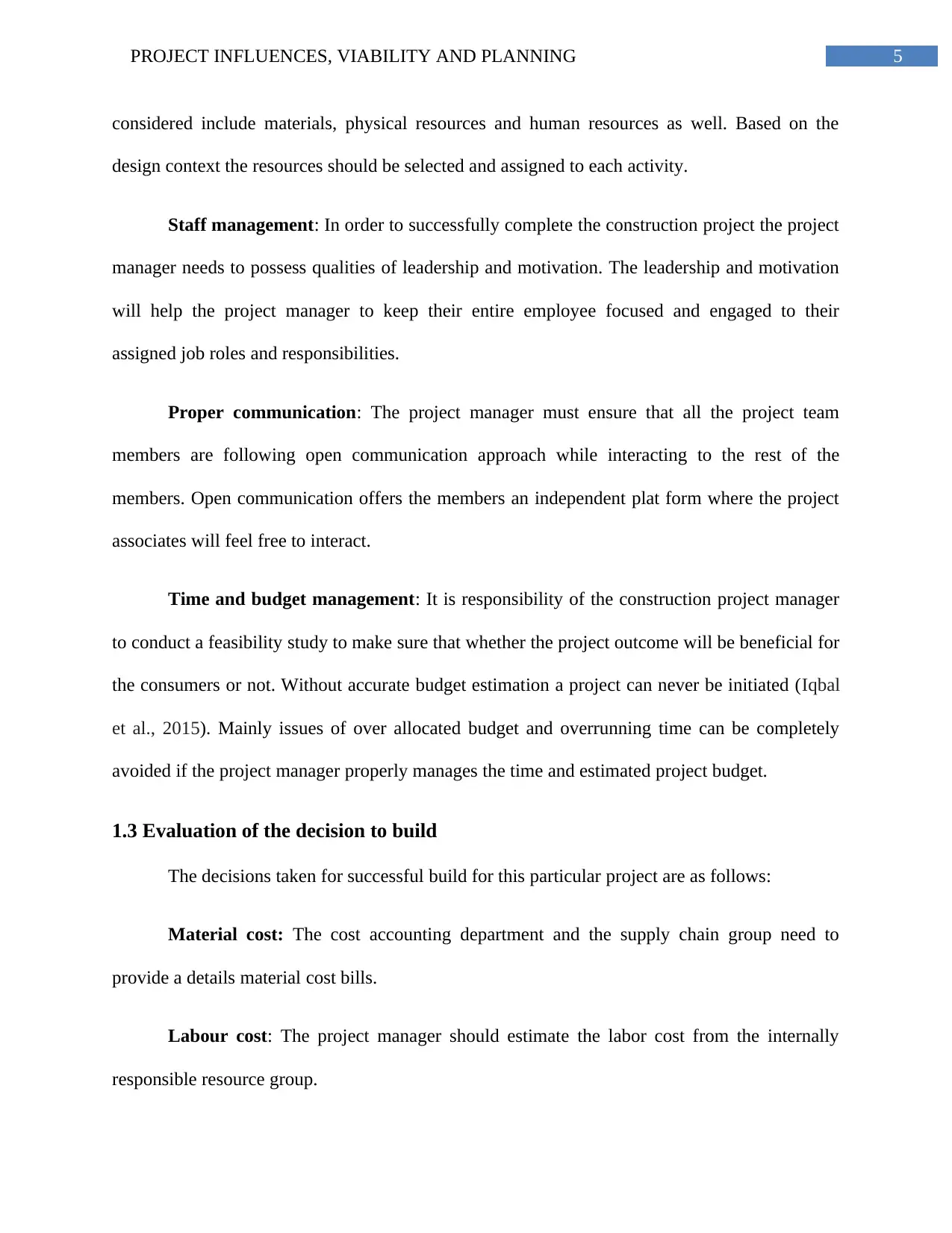
5PROJECT INFLUENCES, VIABILITY AND PLANNING
considered include materials, physical resources and human resources as well. Based on the
design context the resources should be selected and assigned to each activity.
Staff management: In order to successfully complete the construction project the project
manager needs to possess qualities of leadership and motivation. The leadership and motivation
will help the project manager to keep their entire employee focused and engaged to their
assigned job roles and responsibilities.
Proper communication: The project manager must ensure that all the project team
members are following open communication approach while interacting to the rest of the
members. Open communication offers the members an independent plat form where the project
associates will feel free to interact.
Time and budget management: It is responsibility of the construction project manager
to conduct a feasibility study to make sure that whether the project outcome will be beneficial for
the consumers or not. Without accurate budget estimation a project can never be initiated (Iqbal
et al., 2015). Mainly issues of over allocated budget and overrunning time can be completely
avoided if the project manager properly manages the time and estimated project budget.
1.3 Evaluation of the decision to build
The decisions taken for successful build for this particular project are as follows:
Material cost: The cost accounting department and the supply chain group need to
provide a details material cost bills.
Labour cost: The project manager should estimate the labor cost from the internally
responsible resource group.
considered include materials, physical resources and human resources as well. Based on the
design context the resources should be selected and assigned to each activity.
Staff management: In order to successfully complete the construction project the project
manager needs to possess qualities of leadership and motivation. The leadership and motivation
will help the project manager to keep their entire employee focused and engaged to their
assigned job roles and responsibilities.
Proper communication: The project manager must ensure that all the project team
members are following open communication approach while interacting to the rest of the
members. Open communication offers the members an independent plat form where the project
associates will feel free to interact.
Time and budget management: It is responsibility of the construction project manager
to conduct a feasibility study to make sure that whether the project outcome will be beneficial for
the consumers or not. Without accurate budget estimation a project can never be initiated (Iqbal
et al., 2015). Mainly issues of over allocated budget and overrunning time can be completely
avoided if the project manager properly manages the time and estimated project budget.
1.3 Evaluation of the decision to build
The decisions taken for successful build for this particular project are as follows:
Material cost: The cost accounting department and the supply chain group need to
provide a details material cost bills.
Labour cost: The project manager should estimate the labor cost from the internally
responsible resource group.
⊘ This is a preview!⊘
Do you want full access?
Subscribe today to unlock all pages.

Trusted by 1+ million students worldwide
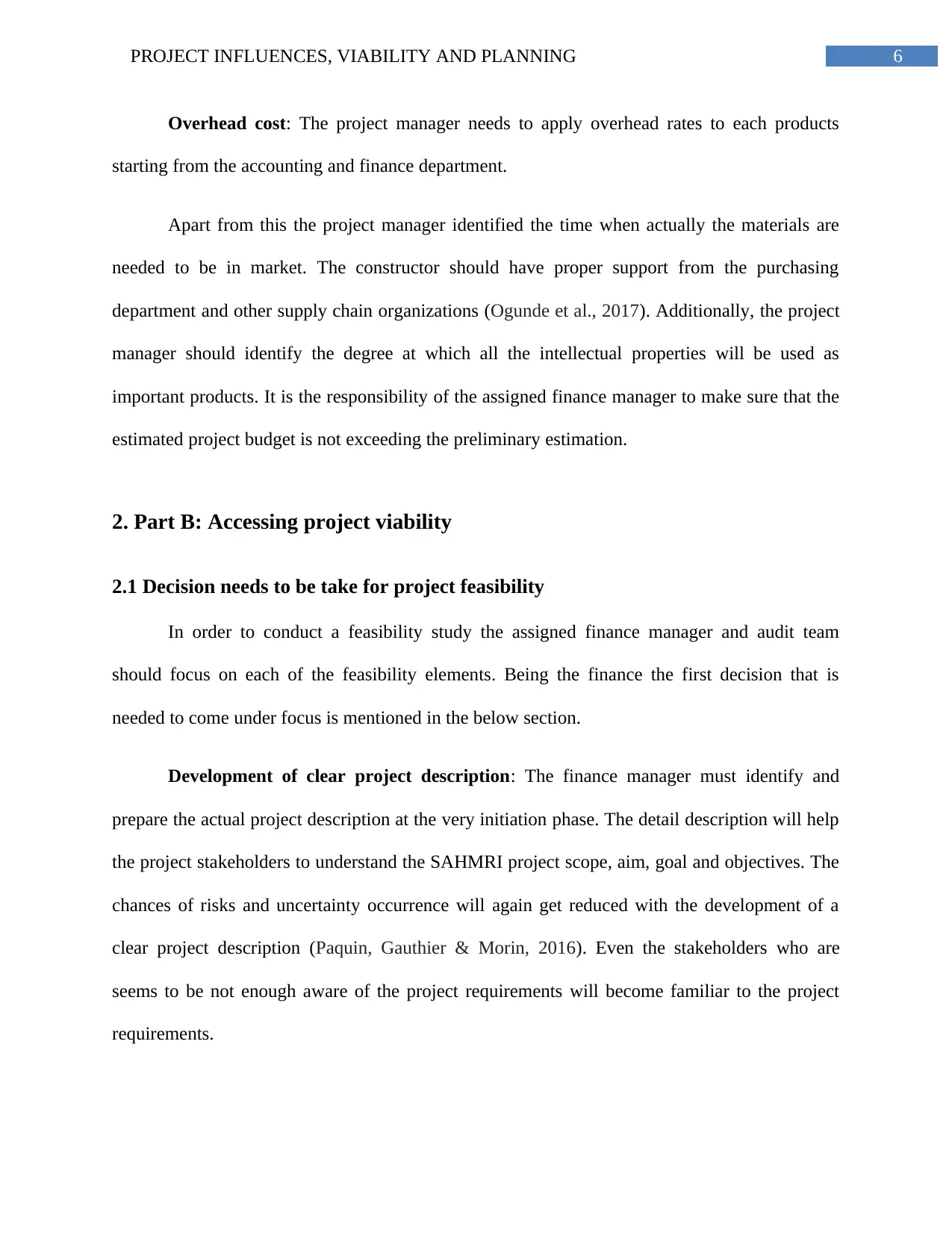
6PROJECT INFLUENCES, VIABILITY AND PLANNING
Overhead cost: The project manager needs to apply overhead rates to each products
starting from the accounting and finance department.
Apart from this the project manager identified the time when actually the materials are
needed to be in market. The constructor should have proper support from the purchasing
department and other supply chain organizations (Ogunde et al., 2017). Additionally, the project
manager should identify the degree at which all the intellectual properties will be used as
important products. It is the responsibility of the assigned finance manager to make sure that the
estimated project budget is not exceeding the preliminary estimation.
2. Part B: Accessing project viability
2.1 Decision needs to be take for project feasibility
In order to conduct a feasibility study the assigned finance manager and audit team
should focus on each of the feasibility elements. Being the finance the first decision that is
needed to come under focus is mentioned in the below section.
Development of clear project description: The finance manager must identify and
prepare the actual project description at the very initiation phase. The detail description will help
the project stakeholders to understand the SAHMRI project scope, aim, goal and objectives. The
chances of risks and uncertainty occurrence will again get reduced with the development of a
clear project description (Paquin, Gauthier & Morin, 2016). Even the stakeholders who are
seems to be not enough aware of the project requirements will become familiar to the project
requirements.
Overhead cost: The project manager needs to apply overhead rates to each products
starting from the accounting and finance department.
Apart from this the project manager identified the time when actually the materials are
needed to be in market. The constructor should have proper support from the purchasing
department and other supply chain organizations (Ogunde et al., 2017). Additionally, the project
manager should identify the degree at which all the intellectual properties will be used as
important products. It is the responsibility of the assigned finance manager to make sure that the
estimated project budget is not exceeding the preliminary estimation.
2. Part B: Accessing project viability
2.1 Decision needs to be take for project feasibility
In order to conduct a feasibility study the assigned finance manager and audit team
should focus on each of the feasibility elements. Being the finance the first decision that is
needed to come under focus is mentioned in the below section.
Development of clear project description: The finance manager must identify and
prepare the actual project description at the very initiation phase. The detail description will help
the project stakeholders to understand the SAHMRI project scope, aim, goal and objectives. The
chances of risks and uncertainty occurrence will again get reduced with the development of a
clear project description (Paquin, Gauthier & Morin, 2016). Even the stakeholders who are
seems to be not enough aware of the project requirements will become familiar to the project
requirements.
Paraphrase This Document
Need a fresh take? Get an instant paraphrase of this document with our AI Paraphraser
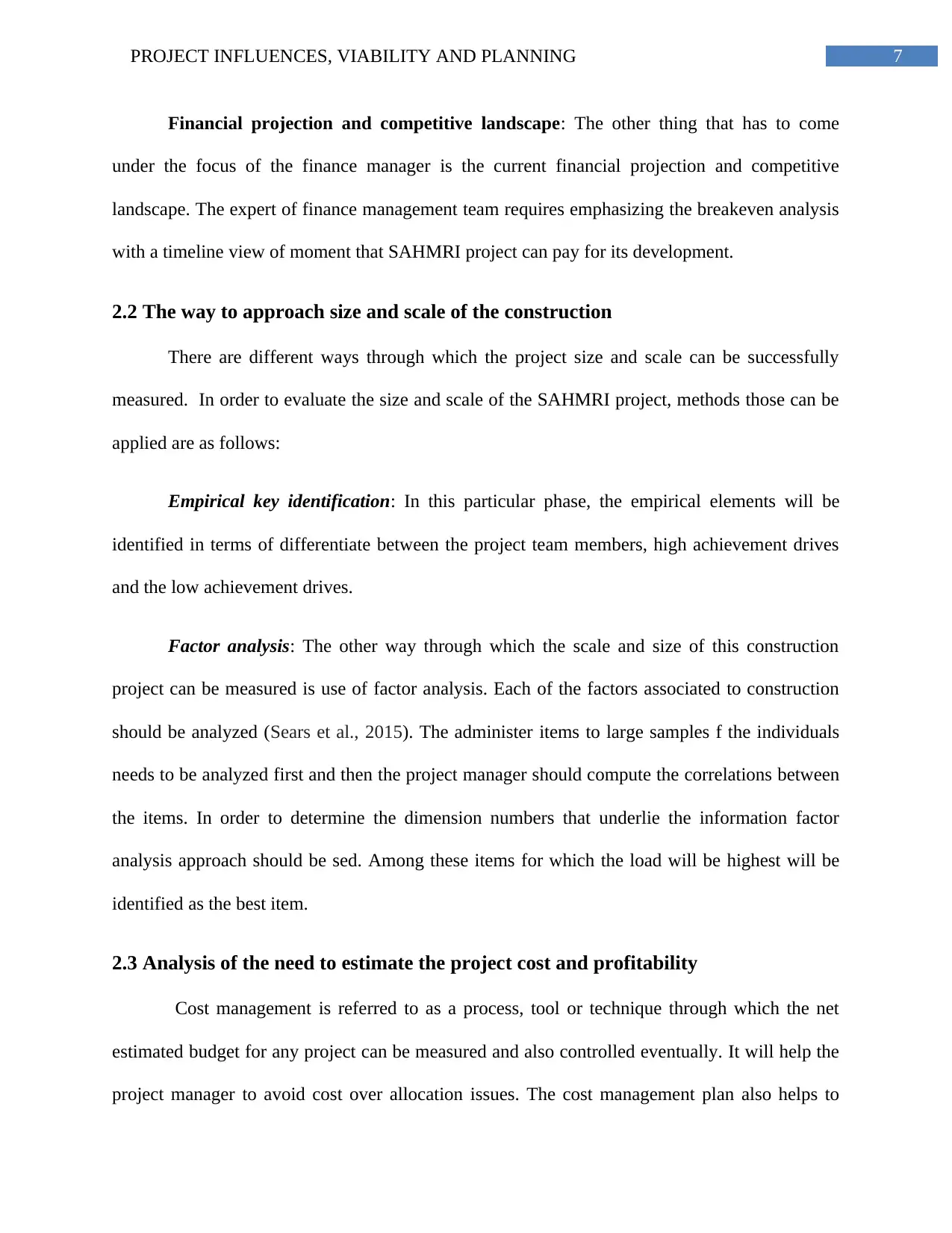
7PROJECT INFLUENCES, VIABILITY AND PLANNING
Financial projection and competitive landscape: The other thing that has to come
under the focus of the finance manager is the current financial projection and competitive
landscape. The expert of finance management team requires emphasizing the breakeven analysis
with a timeline view of moment that SAHMRI project can pay for its development.
2.2 The way to approach size and scale of the construction
There are different ways through which the project size and scale can be successfully
measured. In order to evaluate the size and scale of the SAHMRI project, methods those can be
applied are as follows:
Empirical key identification: In this particular phase, the empirical elements will be
identified in terms of differentiate between the project team members, high achievement drives
and the low achievement drives.
Factor analysis: The other way through which the scale and size of this construction
project can be measured is use of factor analysis. Each of the factors associated to construction
should be analyzed (Sears et al., 2015). The administer items to large samples f the individuals
needs to be analyzed first and then the project manager should compute the correlations between
the items. In order to determine the dimension numbers that underlie the information factor
analysis approach should be sed. Among these items for which the load will be highest will be
identified as the best item.
2.3 Analysis of the need to estimate the project cost and profitability
Cost management is referred to as a process, tool or technique through which the net
estimated budget for any project can be measured and also controlled eventually. It will help the
project manager to avoid cost over allocation issues. The cost management plan also helps to
Financial projection and competitive landscape: The other thing that has to come
under the focus of the finance manager is the current financial projection and competitive
landscape. The expert of finance management team requires emphasizing the breakeven analysis
with a timeline view of moment that SAHMRI project can pay for its development.
2.2 The way to approach size and scale of the construction
There are different ways through which the project size and scale can be successfully
measured. In order to evaluate the size and scale of the SAHMRI project, methods those can be
applied are as follows:
Empirical key identification: In this particular phase, the empirical elements will be
identified in terms of differentiate between the project team members, high achievement drives
and the low achievement drives.
Factor analysis: The other way through which the scale and size of this construction
project can be measured is use of factor analysis. Each of the factors associated to construction
should be analyzed (Sears et al., 2015). The administer items to large samples f the individuals
needs to be analyzed first and then the project manager should compute the correlations between
the items. In order to determine the dimension numbers that underlie the information factor
analysis approach should be sed. Among these items for which the load will be highest will be
identified as the best item.
2.3 Analysis of the need to estimate the project cost and profitability
Cost management is referred to as a process, tool or technique through which the net
estimated budget for any project can be measured and also controlled eventually. It will help the
project manager to avoid cost over allocation issues. The cost management plan also helps to
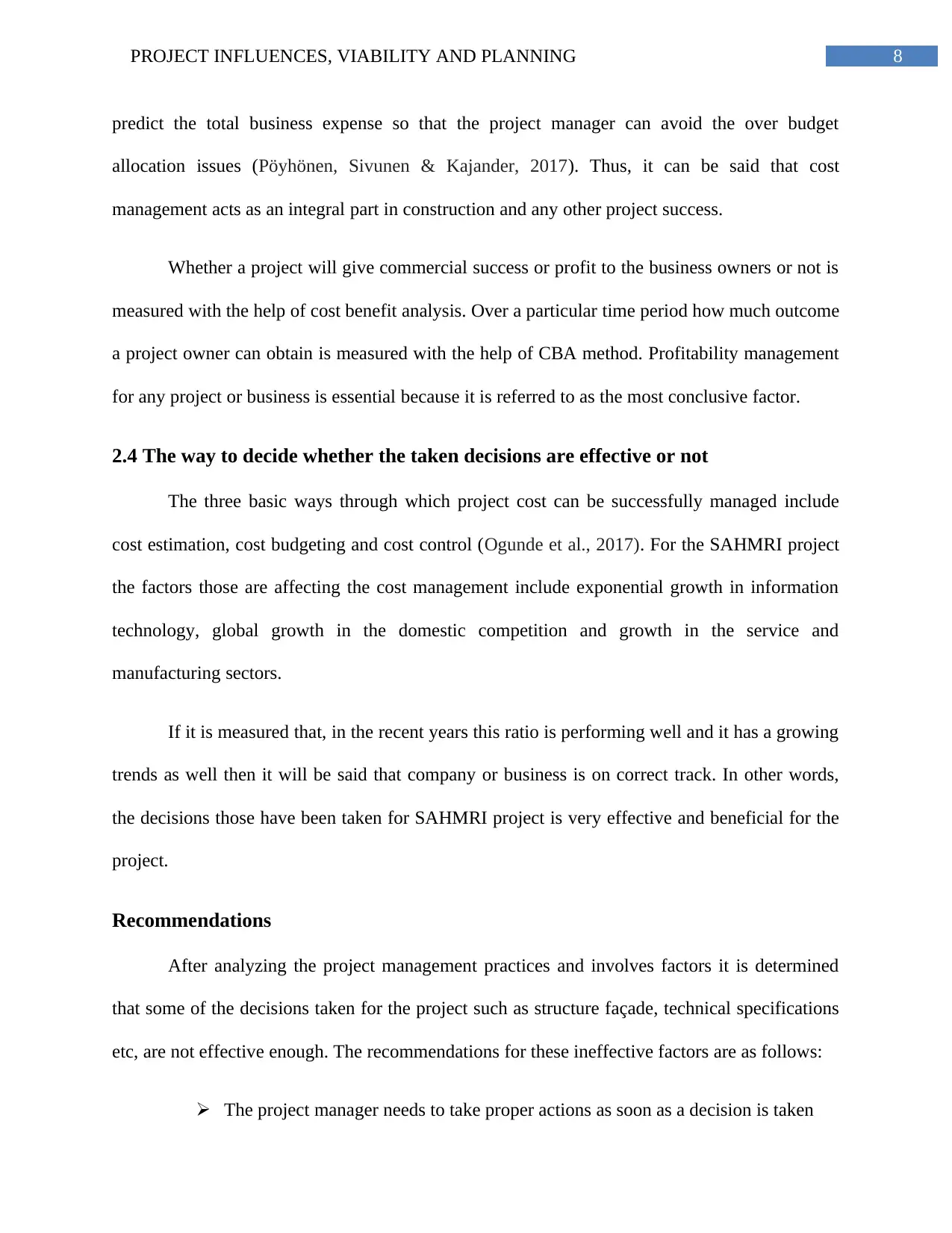
8PROJECT INFLUENCES, VIABILITY AND PLANNING
predict the total business expense so that the project manager can avoid the over budget
allocation issues (Pöyhönen, Sivunen & Kajander, 2017). Thus, it can be said that cost
management acts as an integral part in construction and any other project success.
Whether a project will give commercial success or profit to the business owners or not is
measured with the help of cost benefit analysis. Over a particular time period how much outcome
a project owner can obtain is measured with the help of CBA method. Profitability management
for any project or business is essential because it is referred to as the most conclusive factor.
2.4 The way to decide whether the taken decisions are effective or not
The three basic ways through which project cost can be successfully managed include
cost estimation, cost budgeting and cost control (Ogunde et al., 2017). For the SAHMRI project
the factors those are affecting the cost management include exponential growth in information
technology, global growth in the domestic competition and growth in the service and
manufacturing sectors.
If it is measured that, in the recent years this ratio is performing well and it has a growing
trends as well then it will be said that company or business is on correct track. In other words,
the decisions those have been taken for SAHMRI project is very effective and beneficial for the
project.
Recommendations
After analyzing the project management practices and involves factors it is determined
that some of the decisions taken for the project such as structure façade, technical specifications
etc, are not effective enough. The recommendations for these ineffective factors are as follows:
The project manager needs to take proper actions as soon as a decision is taken
predict the total business expense so that the project manager can avoid the over budget
allocation issues (Pöyhönen, Sivunen & Kajander, 2017). Thus, it can be said that cost
management acts as an integral part in construction and any other project success.
Whether a project will give commercial success or profit to the business owners or not is
measured with the help of cost benefit analysis. Over a particular time period how much outcome
a project owner can obtain is measured with the help of CBA method. Profitability management
for any project or business is essential because it is referred to as the most conclusive factor.
2.4 The way to decide whether the taken decisions are effective or not
The three basic ways through which project cost can be successfully managed include
cost estimation, cost budgeting and cost control (Ogunde et al., 2017). For the SAHMRI project
the factors those are affecting the cost management include exponential growth in information
technology, global growth in the domestic competition and growth in the service and
manufacturing sectors.
If it is measured that, in the recent years this ratio is performing well and it has a growing
trends as well then it will be said that company or business is on correct track. In other words,
the decisions those have been taken for SAHMRI project is very effective and beneficial for the
project.
Recommendations
After analyzing the project management practices and involves factors it is determined
that some of the decisions taken for the project such as structure façade, technical specifications
etc, are not effective enough. The recommendations for these ineffective factors are as follows:
The project manager needs to take proper actions as soon as a decision is taken
⊘ This is a preview!⊘
Do you want full access?
Subscribe today to unlock all pages.

Trusted by 1+ million students worldwide
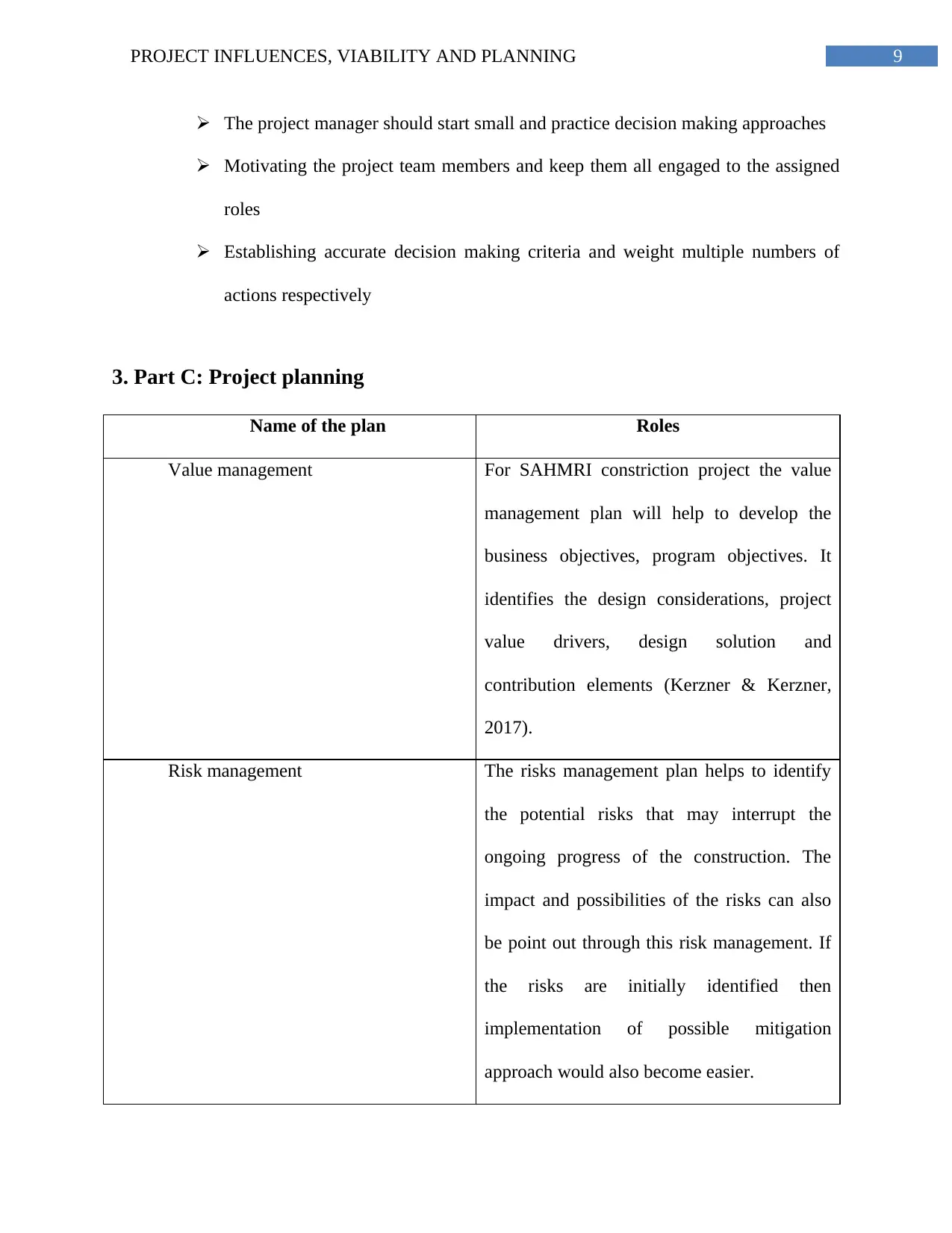
9PROJECT INFLUENCES, VIABILITY AND PLANNING
The project manager should start small and practice decision making approaches
Motivating the project team members and keep them all engaged to the assigned
roles
Establishing accurate decision making criteria and weight multiple numbers of
actions respectively
3. Part C: Project planning
Name of the plan Roles
Value management For SAHMRI constriction project the value
management plan will help to develop the
business objectives, program objectives. It
identifies the design considerations, project
value drivers, design solution and
contribution elements (Kerzner & Kerzner,
2017).
Risk management The risks management plan helps to identify
the potential risks that may interrupt the
ongoing progress of the construction. The
impact and possibilities of the risks can also
be point out through this risk management. If
the risks are initially identified then
implementation of possible mitigation
approach would also become easier.
The project manager should start small and practice decision making approaches
Motivating the project team members and keep them all engaged to the assigned
roles
Establishing accurate decision making criteria and weight multiple numbers of
actions respectively
3. Part C: Project planning
Name of the plan Roles
Value management For SAHMRI constriction project the value
management plan will help to develop the
business objectives, program objectives. It
identifies the design considerations, project
value drivers, design solution and
contribution elements (Kerzner & Kerzner,
2017).
Risk management The risks management plan helps to identify
the potential risks that may interrupt the
ongoing progress of the construction. The
impact and possibilities of the risks can also
be point out through this risk management. If
the risks are initially identified then
implementation of possible mitigation
approach would also become easier.
Paraphrase This Document
Need a fresh take? Get an instant paraphrase of this document with our AI Paraphraser
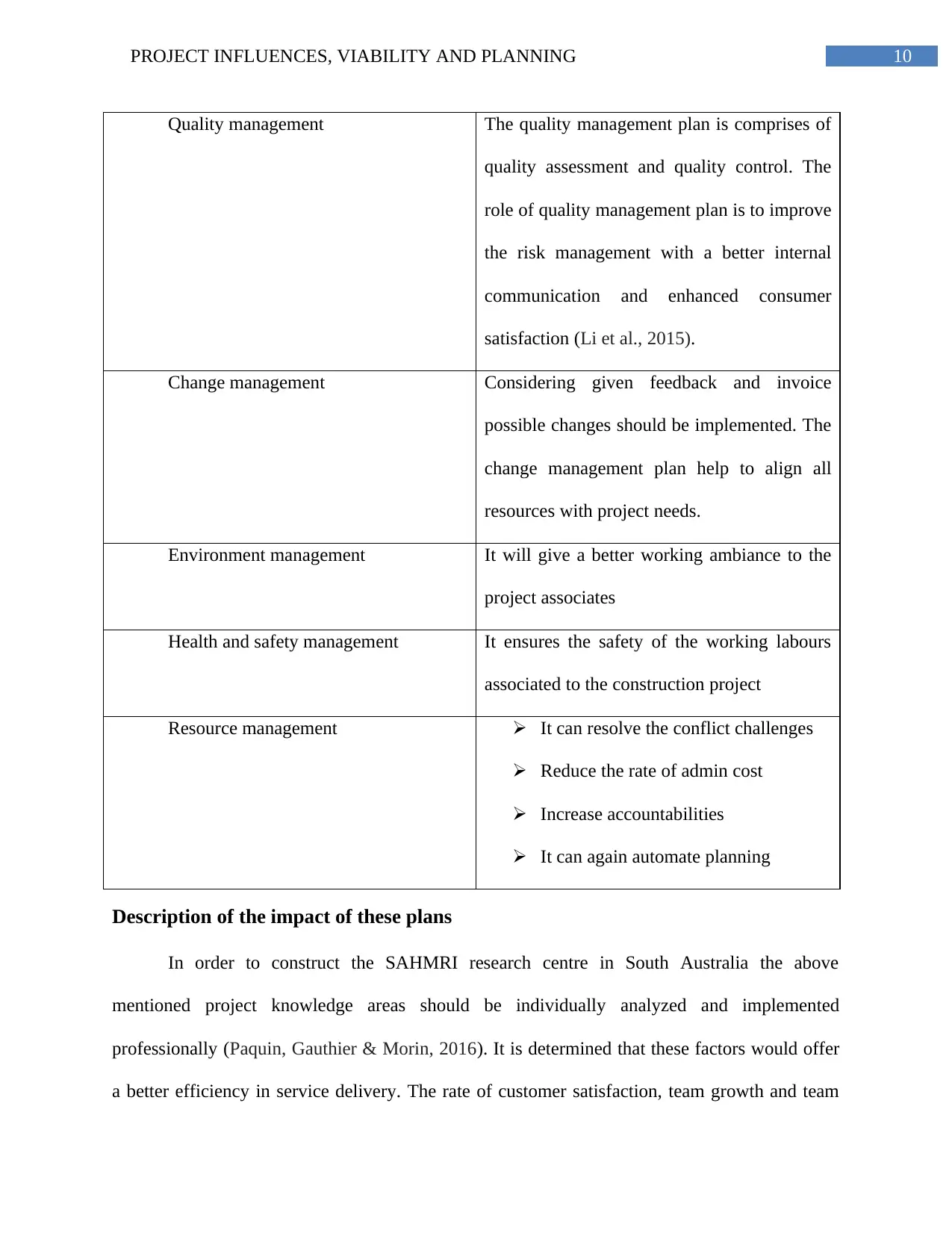
10PROJECT INFLUENCES, VIABILITY AND PLANNING
Quality management The quality management plan is comprises of
quality assessment and quality control. The
role of quality management plan is to improve
the risk management with a better internal
communication and enhanced consumer
satisfaction (Li et al., 2015).
Change management Considering given feedback and invoice
possible changes should be implemented. The
change management plan help to align all
resources with project needs.
Environment management It will give a better working ambiance to the
project associates
Health and safety management It ensures the safety of the working labours
associated to the construction project
Resource management It can resolve the conflict challenges
Reduce the rate of admin cost
Increase accountabilities
It can again automate planning
Description of the impact of these plans
In order to construct the SAHMRI research centre in South Australia the above
mentioned project knowledge areas should be individually analyzed and implemented
professionally (Paquin, Gauthier & Morin, 2016). It is determined that these factors would offer
a better efficiency in service delivery. The rate of customer satisfaction, team growth and team
Quality management The quality management plan is comprises of
quality assessment and quality control. The
role of quality management plan is to improve
the risk management with a better internal
communication and enhanced consumer
satisfaction (Li et al., 2015).
Change management Considering given feedback and invoice
possible changes should be implemented. The
change management plan help to align all
resources with project needs.
Environment management It will give a better working ambiance to the
project associates
Health and safety management It ensures the safety of the working labours
associated to the construction project
Resource management It can resolve the conflict challenges
Reduce the rate of admin cost
Increase accountabilities
It can again automate planning
Description of the impact of these plans
In order to construct the SAHMRI research centre in South Australia the above
mentioned project knowledge areas should be individually analyzed and implemented
professionally (Paquin, Gauthier & Morin, 2016). It is determined that these factors would offer
a better efficiency in service delivery. The rate of customer satisfaction, team growth and team
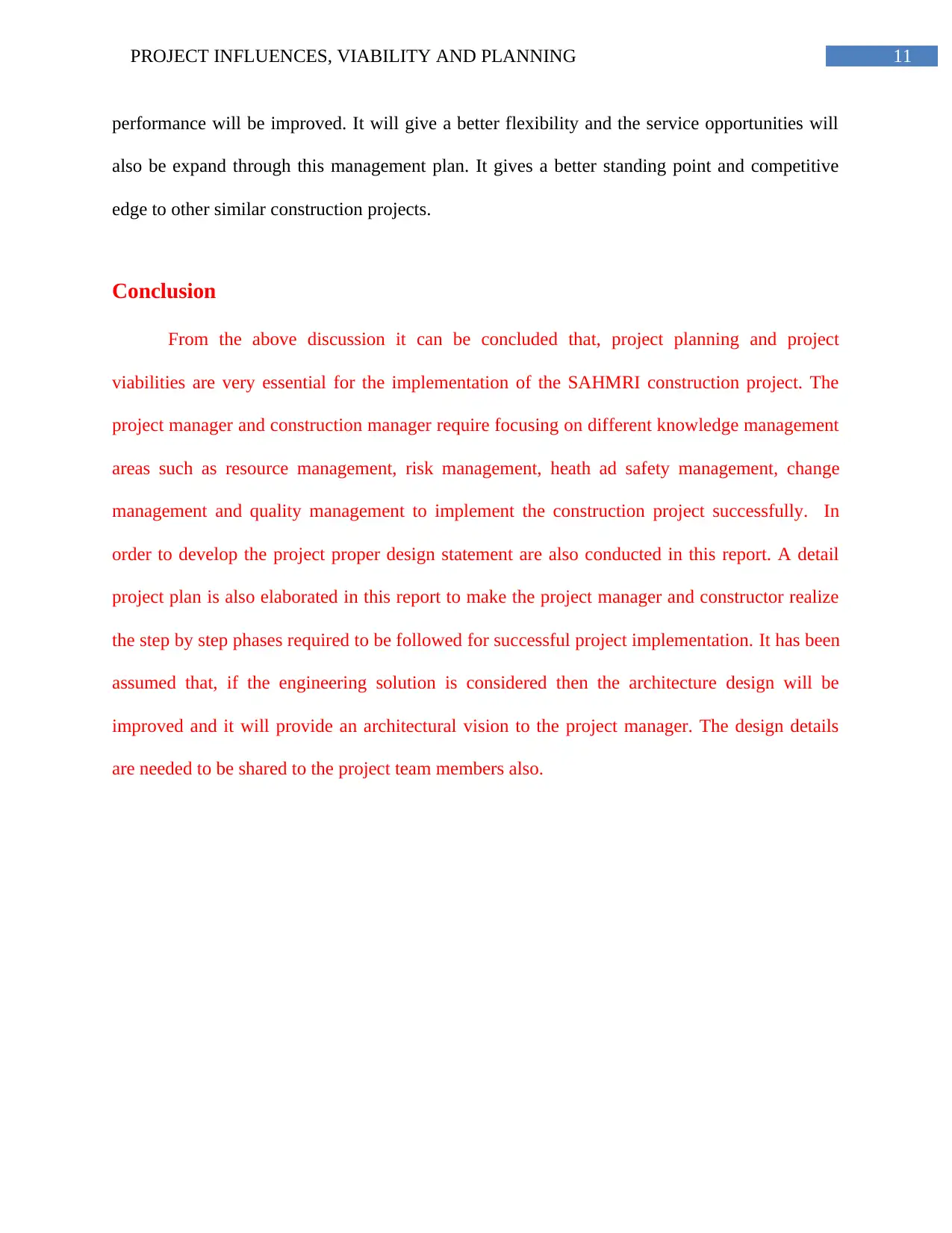
11PROJECT INFLUENCES, VIABILITY AND PLANNING
performance will be improved. It will give a better flexibility and the service opportunities will
also be expand through this management plan. It gives a better standing point and competitive
edge to other similar construction projects.
Conclusion
From the above discussion it can be concluded that, project planning and project
viabilities are very essential for the implementation of the SAHMRI construction project. The
project manager and construction manager require focusing on different knowledge management
areas such as resource management, risk management, heath ad safety management, change
management and quality management to implement the construction project successfully. In
order to develop the project proper design statement are also conducted in this report. A detail
project plan is also elaborated in this report to make the project manager and constructor realize
the step by step phases required to be followed for successful project implementation. It has been
assumed that, if the engineering solution is considered then the architecture design will be
improved and it will provide an architectural vision to the project manager. The design details
are needed to be shared to the project team members also.
performance will be improved. It will give a better flexibility and the service opportunities will
also be expand through this management plan. It gives a better standing point and competitive
edge to other similar construction projects.
Conclusion
From the above discussion it can be concluded that, project planning and project
viabilities are very essential for the implementation of the SAHMRI construction project. The
project manager and construction manager require focusing on different knowledge management
areas such as resource management, risk management, heath ad safety management, change
management and quality management to implement the construction project successfully. In
order to develop the project proper design statement are also conducted in this report. A detail
project plan is also elaborated in this report to make the project manager and constructor realize
the step by step phases required to be followed for successful project implementation. It has been
assumed that, if the engineering solution is considered then the architecture design will be
improved and it will provide an architectural vision to the project manager. The design details
are needed to be shared to the project team members also.
⊘ This is a preview!⊘
Do you want full access?
Subscribe today to unlock all pages.

Trusted by 1+ million students worldwide
1 out of 15
Related Documents
Your All-in-One AI-Powered Toolkit for Academic Success.
+13062052269
info@desklib.com
Available 24*7 on WhatsApp / Email
![[object Object]](/_next/static/media/star-bottom.7253800d.svg)
Unlock your academic potential
Copyright © 2020–2025 A2Z Services. All Rights Reserved. Developed and managed by ZUCOL.





